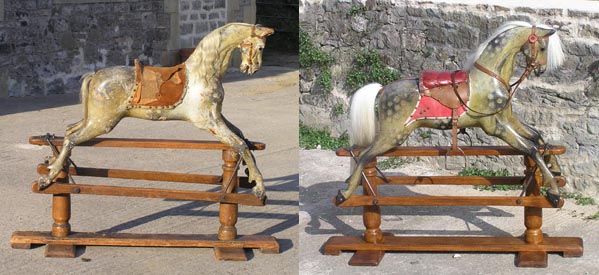Occasionally a rocking horse arrives with its original paintwork - a treat! In these cases the paintwork and features
are preserved as far as possible. The knocks, scratches and small cracks that these rocking horses show are not flaws but
honourable scars from years of use and this patina should not be removed. Any missing parts are replaced as
sympathetically as possible. This picture shows what can be done by overpainting
the damaged areas, enhancing the dapples, repairing the serious cracks and replacing the hair and tack.
The horse still looks his age and retains about 70% of its original paint.

The following pictures show some of the stages of rocking horse restoration.
(and before you ask, names are easier than stock numbers - that's the theory anyway)
- Pommers On arrival and restored.
- Paintwork Finding the original paint
- Woodwork Revealing the wood
- Heads Woodwork repairs to heads
- Legs Repairs to legs
- More Legs Repairs to leg joints
- Serious repairs Broken neck and more
- GessoOld rocking horses with new gesso
- Paint New paint for old horses
- Hair New manes and tails
- Saddlery New saddlery
- Odds and ends Miscellaneous restoration pictures
- Before and after Some old rocking horses
